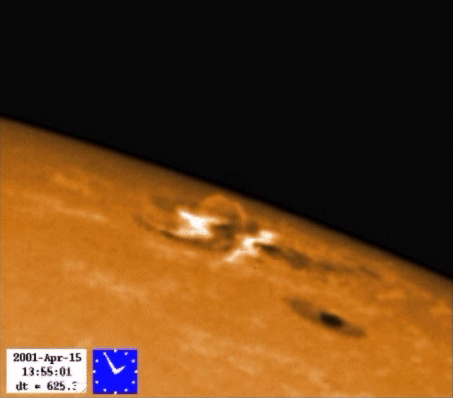Reality Check
Penultimate Amazing
These are some of the questions that MM has been asked about his Iron Sun idea and seems incapable of answering other than by unsupported assertions.

- What is the amount of 171A light emitted by the photosphere and can it be detected? First asked 6th July 2009
- A post that seemed to retract his "mountain ranges" on the TRACE 171A RD animation evoked this question:
What discharge rates and processes come from your hypothetical thermodynamically impossible solid iron surface to show up as records of change in the RD animation in the corona. First asked 6th July 2009 - From tusenfem:
Where is the the solar wind and the appropriate math in Birkeland's book? First asked 7th July 2009 - Please cite where in his book Birkeland identified fission as the "original current source" and in the same post
- Please cite where in his book Birkeland identified a discharge process between the Sun's surface and the heliosphere (about 10 billion kilometers from the Sun). First asked 7th July 2009
- Is your solid iron surface thermodynamically possible? First asked 8 July 2009
See this post for a fuller explanation of the thermodynamic problems with MM's solid iron surface. - Coronal loops are electrical discharges? First asked 10 July 2009
This is an updated question with a couple of "answers" from MM. - Can Micheal Mozina answer a simple RD animation question? First asked 10 July 2009
- More questions for Michael Mozina about the photosphere optical depth First asked 13 July 2009
- Formation of the iron surface First asked 13 July 2009
- How much is "mostly neon" MM? First asked 13 July 2009
- Just how useless is the Iron Sun model? First asked 13 July 2009
- Coronal loop heating question for Michael Mozina First asked 13 July 2009
- Coronal loop stability question for Michael Mozina First asked 13 July 2009He does link to his copy of Alfvén and Carlqvist's 1966 paper (Currents in the Solar Atmosphere and A theory of Solar Flares). This does not model what we now know a real solar flare acts like.
- Has the hollow Iron Sun been tested? First asked 14 July 2009
- Is Saturn the Sun? First asked 14 July 2009(Birkelands Fig 247a is an analogy for Saturn's rings but MM compares it to to the Sun).
- Question about "streams of electrons" for Micheal Mozina First asked 14 July 2009MM has one reply in which is mistakenly thinks that this question is about coronal loops.
- What is the temperature above the iron crust in the Iron Sun model? First asked 17 July 2009
- What part of the Sun emits a nearly black body spectrum with an effective temperature of 5777 K?
(MM states that it is not the photosphere) First asked 18 July 2009 - Is the iron surface is kept cooler than the photosphere by heated particles? First asked 18 July 2009
- Entire photon "spectrum" is composed of all the emissions from all the layers First asked 3 August 2009
- Same event in different passbands = surface of the Sun moves? First asked 22 July 2009
Seems to think that 3 pixel differences (full Sun image) or 10's of pixels (limb image) are not detectable. Astronomers would disagree. - Evidence for the existence of "dark" electrons First asked 28 July 2008
- Why neon for your "mostly neon" photosphere? First asked 30 July 2009
- Where is the "mostly fluorine" layer? First asked 30 July 2009
- What is your physical evidence for "mostly Li/Be/B/C/N/O" layers? First asked 30 July 2009
- What is your physical evidence for the "mostly deuterium" layer? First asked 30 July 2009
- Explain the shape of your electrical arcs (coronal loops) First asked 2 August 2009
- What is your physical evidence for the silicon in sunspots? First asked 7 August 2009
- How do MM's "layers" survive the convection currents in the Sun? First asked 26 December 2009
- Where are the controllable empirical experiments showing the Iron Sun mass separation?
First asked 5 January 2010 - How can your iron "crust" not be a plasma at a temperature of at least 9400 K?
First asked 7 April 2010 - How can your "mountain ranges" be at a temperature of at least 160,000 K?
First asked 8 April 2010 - Where is the spike of Fe composition in the remnants of novae and supernovae?
First asked 8 April 2010 - Which images did you use as your input for the PM-A.gif image, etc.?
First asked 8 April 2010


 !
!
 !
!